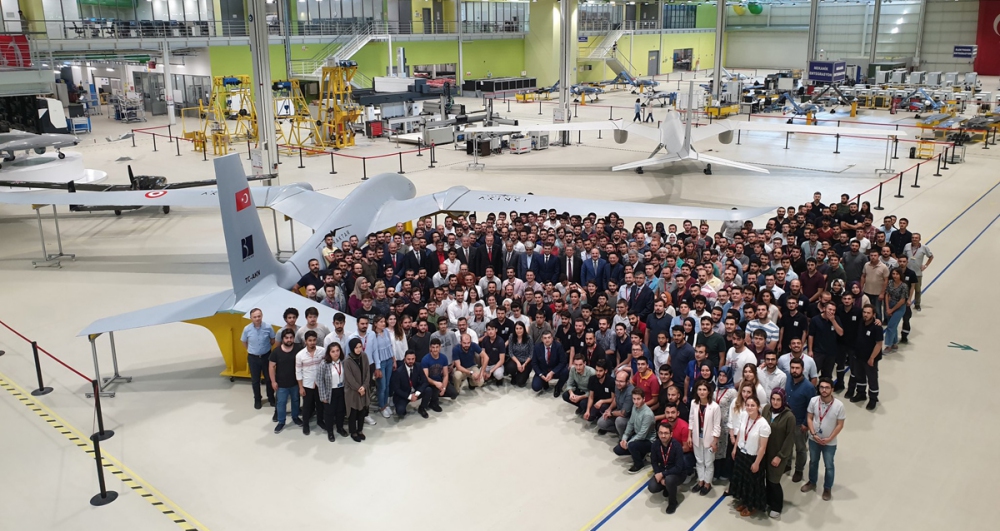
Baykar staff pose with the prototype Bayraktar Akıncı in the factory, with production Bayraktar TB2s in the background
Turkey’s newest armed drone, the Bayraktar Akıncı (Raider), successfully completed a 16-minute maiden flight on December 6, 2019. The flight was undertaken from the Turkish Army’s Çorlu airfield in Turkey’s northwestern Tekirdağ province. The aircraft made a fully automatic takeoff and landing during the brief test.
The manufacturer of the Akıncı (which is reportedly nicknamed the “flying fish”) is Baykar Makina AŞ. The company was established in 1984 and initially undertook precision machining for the automotive supply industry, beginning work on Unmanned Aerial Vehicle Systems in 2000. Baykar flew a Mini UAV prototype in 2005 (production versions were delivered to the armed forces two years later) and a rotary-wing UAV in 2006, before starting development of a Tactical Class UAV system in 2007. The Tactical Class UAV was developed into the production Bayraktar TB2, which made its first fully automatic test flight in 2014, with deliveries beginning later that year.
The TB2, which has been exported to Qatar and Ukraine, is a 630-kg tactical medium-altitude, long-endurance UAV. Of twin-boom configuration with a single pusher propeller, the TB2 is powered by a 100-hp piston engine and carries a payload of up to 55 kg, permitting the carriage of small weapons.
Turkey’s SSB (presidency of defense industries) issued a request for information (RFI) for the development and manufacture of a bigger, more heavily-armed 4.5-tonne high-altitude long-endurance (HALE) UAV as part of the Akıncı Attack UAV program during early 2016. Baykar Makina’s proposal was selected over a rival bid by Turkish Aerospace on January 31, 2018, and in June 2018 the then-Minister of National Defense Nurettin Canikli announced that a contract had been signed. He said that the Akıncı would pave the way for the development of an indigenous unmanned combat aircraft starting in 2027 based on the technology now being developed. The first deliveries of the Akıncı itself were scheduled for 2020 or 2021
Baykar’s chief technology officer Selçuk Bayraktar has described the Akıncı UAV as “a 5.5-tonne aircraft with the ability to carry out more strategic tasks. It can carry cruise missiles.” With a wingspan of 20 meters (66 feet), and length of 12.2 meters (40 feet), the Akıncı is reportedly powered by two 450-hp (340-kW) Ivchenko-Progress AI-450C turboprop engines, though 200-hp (150-kW) or 750-hp (560 kW) engines have been listed as alternatives.
The Akıncı has an endurance of up to 24 hours, flying at an operational altitude of 40,000 feet, and at a range of up to 250 nm from its ground station. It has a total payload of 1,350 kg (2,980 pounds) carrying 400 kg (880 pounds) internally and 950 kg (2,090 pounds) on underwing hardpoints.
The air vehicle will be equipped with indigenously developed mission systems, including an Aselsan-supplied multi-role active electronically scanned array (AESA) radar, a SAR/GMTI radar, a wide-area surveillance system, electronic warfare, ELINT/SIGINT suite, and beyond-line-of-sight (BLoS) satellite communications systems, as well as a CATS FLIR, an ESM pod, and a new collision-avoidance system.
It will also be able to carry a wide range of air-to-ground weapons, including Mk 81/82 bombs, Roketsan MAM-C and MAM-L precision-guided bombs, Cirit laser-guided rockets, and L-UMTAS anti-tank missiles, as well as bombs fitted with the TÜBİTAK-SAGE HGK, KGK, and LGK guidance kits. The 250-km range Roketsan SOM-A cruise missile is also planned for integration, and Baykar Makina general manager Haluk Bayraktar has said that the Akıncı may be equipped with domestically developed air-to-air missiles.
Photo: Baykar
Source: AIN Online
